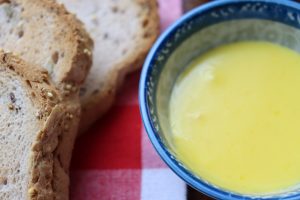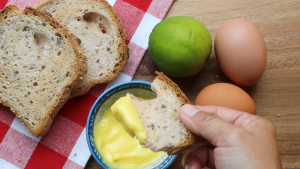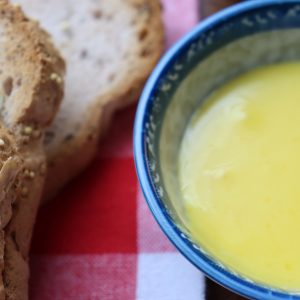Vietnamese Mayonnaise (Sốt Mayonnaise)

Mayonnaise is believed to have originated in the 18th century, though its exact origins are debated. One of the most popular stories traces it back to the island of Menorca, Spain, where French Duke of Richelieu’s chef created it after a victory in 1756. The sauce was initially called “mahónnaise,” named after the port city of Mahón, where it was supposedly invented.
Over time, the French adopted and refined the recipe, turning mayonnaise into a staple of French cuisine. From there, it spread across Europe and eventually the world, with various cultures adding their own twists to the classic emulsion of egg yolks and oil. Today, mayonnaise is a versatile and widely used condiment in everything from sandwiches to salads, with regional variations such as the tangy Vietnamese version used in bánh mì.
How does Vietnamese mayonnaise differ from other versions?
The Vietnamese version of mayonnaise, often used in bánh mì, differs from traditional Western mayonnaise in a few key ways:
- Tanginess: Vietnamese mayonnaise incorporates lime juice, giving it a brighter, tangier flavour compared to the more neutral acidity from vinegar or lemon juice found in Western versions.
- Sweeter flavour: It typically has added sugar, making it slightly sweeter than classic mayonnaise, which usually emphasizes a savoury profile.
- Garlic-infused oil: In some recipes, garlic-infused olive oil is used, imparting a subtle garlicky flavour that adds depth and complexity, which is less common in other versions.
- Lighter texture: Vietnamese mayonnaise tends to be lighter and less thick, which makes it ideal for spreading in sandwiches like bánh mì without overpowering the other ingredients.
Q&As on Vietnamese Mayonnaise
1. Why do I need to add oil slowly and in small amounts when making mayonnaise?
Adding oil slowly and in small amounts at the beginning is essential to ensure the proper emulsification of the mayonnaise. Gradually incorporating the oil helps the egg yolks and oil blend smoothly, creating a stable mixture. If too much oil is added too quickly, the mayonnaise can separate, resulting in a broken or runny texture instead of a thick, creamy consistency.

2. Why is olive oil recommended for making mayonnaise instead of other oils?
Olive oil is recommended for making mayonnaise because it adds a rich, slightly fruity flavour that complements the creamy texture. Its natural flavour enhances the taste of the mayonnaise, especially in dishes like bánh mì. Additionally, olive oil emulsifies well with egg yolks, resulting in a smooth, stable consistency. While other oils can be used, they often have a more neutral taste and may not provide the same depth of flavour as olive oil.
3. Are there any health cautions to consider when consuming mayonnaise?
Yes, there are a few health cautions to keep in mind when consuming mayonnaise. Since it is typically made with raw egg yolks, there is a risk of salmonella contamination if the eggs are not properly handled or pasteurized. It’s important to use fresh, high-quality eggs or opt for pasteurized ones. Additionally, mayonnaise is high in fat and calories, so eating it in moderation is recommended, especially for those watching their cholesterol or calorie intake. Store homemade mayonnaise in the fridge and consume it within 1-2 weeks to avoid spoilage.
4. What are the benefits of making homemade mayonnaise compared to store-bought?
Homemade mayonnaise offers several benefits over store-bought versions. First, you have complete control over the ingredients, allowing you to use fresh, high-quality products without preservatives or additives commonly found in store-bought mayonnaise. You can also adjust the flavour to your preference, whether you want it tangier, sweeter, or more garlicky. Additionally, homemade mayonnaise tends to have a fresher, richer taste and smoother texture. It can also be customized with different oils or flavourings, making it a versatile option for various dishes.
5. Is using an electric egg beater recommended for making mayonnaise?
Yes, an electric egg beater is recommended for making mayonnaise as it helps to achieve a smooth, consistent texture more efficiently. The steady, fast mixing ensures proper emulsification of the egg yolks and oil, which is essential for a stable and creamy mayonnaise. While it is possible to make mayonnaise by hand with a whisk, using an electric beater saves time and effort, especially during the gradual addition of oil.

How to Make Vietnamese Mayonnaise
Equipment
- 1 electric egg beater
Ingredients
- 2 egg yolks
- 150 mL garlic-infused olive oil (or regular olive oil)
- 1 tablespoon sugar
- 1 tablespoon lime juice
- 1/2 teaspoon salt
- 1 teaspoon warm water
Instructions
- In a small bowl, combine 1 tablespoon sugar, 1 tablespoon lime juice, 1/2 teaspoon salt, and 1 teaspoon warm water. Stir until the sugar dissolves, then set aside.
- Pour 150 mL garlic-infused olive oil (or regular olive oil) into a small bowl for easy access.
- Crack 2 eggs, separating the yolks from the whites. Place the yolks in a deep-bottom mixing bowl.
- Use a small hand-held whisk or egg beater to begin whisking the egg yolks until they are smooth.
- While whisking continuously, use a teaspoon to slowly drizzle in a small amount of oil. Whisk for about 30 seconds before adding more. Be careful not to add too much oil at once.
- Gradually repeat step 5 until the mixture becomes thicker and smoother. As it thickens, you can begin adding slightly larger amounts of oil each time while whisking well to maintain consistency.
- Continue whisking and adding oil in this manner until all the oil is incorporated and the mayonnaise is thick and smooth.
- Once the mayonnaise is ready, add the mixture of sugar, lime juice, salt, and water. Adjust the taste if needed. Whisk well until fully combined.
- Vietnamese Mayonnaise is now ready. Transfer it to a sealed jar or container and store it in the fridge. The mayonnaise will last for about 1-2 weeks.

